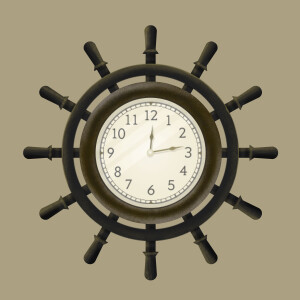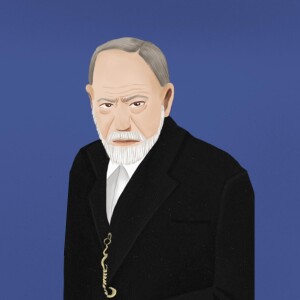Episodes

Saturday Oct 07, 2023
Saturday Oct 07, 2023
Chapter 1:what is the Contagious about
"Contagious: How to Build Word of Mouth in the Digital Age" by Jonah Berger is a book that explores the science behind why certain ideas, products, or behaviors become popular while others do not. Berger, a professor at the Wharton School of the University of Pennsylvania, combines research and real-life examples to uncover the key factors that contribute to the contagiousness of ideas and how to apply them to increase word-of-mouth (WOM) marketing.
The book introduces six principles or "STEPPS" that influence the spread of ideas: Social Currency, Triggers, Emotion, Public, Practical Value, and Stories. Berger explains how understanding and utilizing these principles can help individuals, businesses, and organizations create and promote ideas that are more likely to be shared and replicated.
By examining successful viral marketing campaigns, memorable advertisements, and popular trends, Berger provides insights into the psychology of why people share certain content and why some ideas catch on while others fizzle out. He also discusses the impact of social media platforms on word of mouth and how to harness their potential for generating buzz.
Overall, "Contagious" aims to provide a framework for anyone looking to make their ideas more contagious and generate organic and influential buzz through understanding the psychology of sharing.
Chapter 2:Author of the Contagious
Jonah Berger is a renowned author, professor, and expert in the field of social influence and word-of-mouth marketing. He gained worldwide recognition for his bestselling book "Contagious: How to Build Word of Mouth in the Digital Age," in which he explores the science behind what makes ideas and products go viral.
Berger is currently a marketing professor at the Wharton School at the University of Pennsylvania. He earned his Bachelor's degree from Stanford University and his PhD from Stanford Graduate School of Business.
In addition to his academic credentials, Berger has consulted for numerous companies, helping them understand how to create contagious content and generate buzz around their products and ideas. His research has been featured in prestigious publications like The New York Times, Harvard Business Review, and The Wall Street Journal.
What sets Jonah Berger apart is his ability to combine rigorous academic research with practical advice, making his work accessible and actionable for both marketers and general readers. "Contagious" has been praised for its insights into the psychology of sharing and its practical tips on how to design content and marketing campaigns that are more likely to be talked about and shared.
Overall, Jonah Berger is a leading authority on the power of contagious ideas, and his work continues to shape and influence the fields of marketing and social influence.
Chapter 3:why is the Contagious worth reading
"Contagious: How to Build Word of Mouth in the Digital Age" by Jonah Berger is worth reading for several reasons:
Insights into viral marketing: Berger provides in-depth analysis of why certain ideas, products, or content become viral sensations, while others struggle to gain any traction. Understanding the underlying psychology and principles behind contagious ideas can be immensely valuable for marketers and business owners trying to promote their offerings.
Practical strategies: The book offers a range of practical strategies and techniques to make ideas more contagious. Berger introduces six essential principles (STEPPS): Social Currency, Triggers, Emotion, Public, Practical Value, and Stories, which can be applied to design more shareable content and make brands more talk-worthy.
Real-world examples: Berger backs up his theories with numerous real-world examples, anecdotes, and case studies from various industries. These examples help readers grasp the concepts in a tangible way, making it easier to apply the principles discussed.
Research-backed insights: The book draws on Berger's extensive research in social psychology, as well as studies from other experts in the field. He presents the findings in an accessible manner, making it easier for readers to understand the science behind contagious ideas.
Valuable for personal growth: The principles shared in "Contagious" are not limited to just business or marketing. They can also be applied to personal growth and self-improvement. Understanding what makes ideas contagious can help individuals make their ideas, stories, or messages spread among their social circles, enhancing their influence and impact.
In summary, "Contagious" is worth reading for its insights into viral marketing, practical strategies, real-world examples, research-backed insights, and potential personal growth applications. Whether one is a marketer, business owner, or simply interested in understanding the mechanisms behind contagious ideas, this book offers valuable and actionable information.
Chapter 4: Books like the Contagious
"Made to Stick: Why Some Ideas Survive and Others Die" by Chip Heath and Dan Heath - This book explores the characteristics of ideas that stick in people's minds and become contagious, using real-life examples and practical tips.
"Influence: The Psychology of Persuasion" by Robert Cialdini - This book discusses the principles of persuasion and how certain techniques can make ideas more contagious and influential.
"The Tipping Point: How Little Things Can Make a Big Difference" by Malcolm Gladwell - Similar to "Contagious," this book explores the factors that contribute to the spread of trends and ideas, using case studies and analysis of social dynamics.
"Thinking, Fast and Slow" by Daniel Kahneman - This book delves into the different systems of thinking that influence decision-making and behavior, shedding light on the cognitive processes that make ideas more contagious.
"Epidemics and Society: From the Black Death to the Present" by Frank M. Snowden - This book provides an historical perspective on the spread of contagious diseases and the societal impact they have had throughout history.
"Contagion: How Commerce Has Spread Disease" by Mark Harrison - This book examines the historical relationship between commerce, migration, and the spread of diseases, illustrating how economic interactions can contribute to the contagion of both ideas and illnesses.
"Hit Makers: The Science of Popularity in an Age of Distraction" by Derek Thompson - This book explores the factors that make certain cultural products, ideas, and phenomena popular and contagious in today's crowded and fast-paced media landscape.
"The Power of Habit: Why We Do What We Do in Life and Business" by Charles Duhigg - While not solely focused on contagious ideas, this book delves into the science behind habits and how they can create a ripple effect in behavior and influence the spread of ideas.
"Nudge: Improving Decisions About Health, Wealth, and Happiness" by Richard H. Thaler and Cass R. Sunstein - This book explores the concept of "nudging" and how small changes in decision-making environments can positively influence people's choices. It touches on the contagious nature of ideas and how they can spread when presented in the right way.
"Contagion: How to Build Word of Mouth in the Digital Age" by Jonah Berger - Written by the same author as "Contagious," this book dives deeper into the principles and strategies for fostering word-of-mouth marketing and creating contagious ideas in the modern digital era.

Saturday Oct 07, 2023
Saturday Oct 07, 2023
Chapter 1:Summary of book Gut
"Gut: The Inside Story of Our Body's Most Underrated Organ" is a book written by Giulia Enders, a German medical student, and it explores the importance of the gut in maintaining overall health. The book provides a comprehensive understanding of the gut's functions and how it affects our well-being.
Enders begins by explaining the structure and various components of the gut, including the intestines, microbiota, and gut-brain connection. She delves into topics such as digestion, absorption, and the role of gut bacteria in maintaining a healthy immune system.
Enders highlights the impact of lifestyle choices, such as diet, stress, and medication, on the gut microbiota and overall gut health. She emphasizes the importance of diversity in gut bacteria and offers practical advice on how to maintain a balanced and healthy gut.
The author also explores the link between the gut and other health conditions, such as allergies, autoimmune diseases, and mental health disorders. She provides evidence-based information on how gut health can positively or negatively affect these conditions.
Additionally, Enders debunked common misconceptions surrounding gut health, such as the idea that eating certain foods can instantaneously improve digestion or that every person needs to follow the same dietary guidelines for a healthy gut. She clarifies that everyone's gut is unique and recommends experimenting to find what works best for individuals.
Overall, "Gut" by Giulia Enders provides an engaging and informative overview of the gut's crucial role in maintaining overall health. It offers practical advice and debunks myths surrounding gut health, making it a valuable resource for those interested in improving their well-being.
Chapter 2:the meaning of book Gut
"Gut" is a book written by Giulia Enders, a German medical doctor and scientist. In this book, Enders explores the fascinating world of our digestive system, focusing on the gut and its functions. The main purpose of the book is to provide readers with a comprehensive understanding of how the gut works and its influence on our overall health and well-being.
Enders delves into various aspects of gut health, including digestion, nutrient absorption, and the interaction between the gut and the brain through the gut-brain axis. She also discusses the gut microbiota, which refers to the community of trillions of microorganisms that reside in our digestive tract and play a crucial role in our health.
The book goes beyond scientific explanations and incorporates a touch of humor to make the complex subject accessible and engaging for readers. Enders uses relatable anecdotes and examples to explain scientific concepts, making it easier for non-experts to grasp the information.
Overall, "Gut" by Giulia Enders aims to educate readers about the importance of gut health and how they can improve their overall well-being by taking care of their digestive system. It has gained popularity for its informative yet entertaining approach to a topic that is often overlooked.
Chapter 3:Book Gut chapters
1) Introduction: In this chapter, Enders introduces the concept of the gut, often referred to as the "second brain," and discusses its importance in overall health and well-being.
2) A Magnificent Organ: Enders provides an overview of the structure and functions of the gut, highlighting its ability to absorb nutrients, eliminate waste, and host a complex ecosystem of bacteria.
3) The Journey of Food: This chapter focuses on the digestive process, from the moment food enters the mouth to its passage through the esophagus, stomach, and small intestine. Enders explains the role played by various organs in breaking down and absorbing nutrients.
4) The End of the Road: Here, Enders describes the process of waste elimination, detailing the functions of the large intestine and rectum in storing and expelling feces.
5) The Intelligent Gut: This chapter explores the communication network between the gut and the brain, highlighting the role of the enteric nervous system in regulating digestion and influencing emotions and cognition.
6) The Misunderstood Second Brain: Enders delves deeper into the connection between the gut and the brain, discussing the role of gut bacteria in producing neurotransmitters and how imbalances in the gut microbiome can contribute to mental health disorders.
7) Stress and Digestion: In this chapter, Enders explains how stress can negatively impact gut health and digestion, discussing the role of the gut-brain axis and the relationship between stress hormones and gastrointestinal disorders.
8) The Big Role of the Little Helpers: This chapter focuses on the gut microbiome, exploring the different types of bacteria that reside in the gut and their impact on health, including their role in metabolism, immune function, and disease prevention.
9) The Duet of Digestion: Enders discusses the importance of a balanced diet and proper eating habits for maintaining a healthy gut. She explores popular dietary trends and provides practical tips for supporting gut health through nutrition.
10) A Healthy Gut for a Healthy Life: This final chapter summarizes key findings and discusses the importance of maintaining a healthy gut for overall well-being. Enders provides practical recommendations for promoting gut health and suggests future directions for gut research.
These chapter summaries provide a general overview of the topics covered in "Gut" by Giulia Enders. It is important to note that the book contains more detailed information and examples related to each topic.
Chapter 4: Quotes of book Gut
"Your gut is like a second brain, with its own nervous system and millions of nerve cells."
"We often underestimate the power of our gut, but it plays a vital role in our overall health."
"The gut is home to trillions of microbes, which form a complex ecosystem known as the microbiome."
"A healthy gut is the foundation of a healthy body and mind."
"It's important to pay attention to how our gut feels, as it can be a signal of underlying health issues."
"Digestion is not just about breaking down food, but also about absorbing and utilizing nutrients."
"The gut-brain axis is a communication network between the gut and the brain, and plays a crucial role in our emotions and mental health."
"Probiotics, the good bacteria in our gut, can help maintain a healthy microbiome."
"The gut can influence our immune system, metabolism, and even our weight."
"Taking care of our gut through a balanced diet, regular exercise, and stress management is essential for our overall well-being."

Friday Sep 15, 2023
Friday Sep 15, 2023
Chapter 1:What is Influence about
Influence: The Psychology of Persuasion by Robert B. Cialdini is a book that delves into the principles and tactics behind persuasion and influence. Cialdini analyzes the six key principles that drive human behavior and explains how they can be utilized ethically in various situations to increase compliance and influence others.
The six principles Cialdini discusses are reciprocity, scarcity, authority, consistency, liking, and consensus. He explains how these principles can be effectively employed by individuals and organizations to persuade and influence others to make certain decisions or take specific actions.
Cialdini provides numerous examples and case studies from various fields, including sales, marketing, politics, and social psychology, to demonstrate how these principles work in real-life situations. He also highlights common techniques and tactics used by influence professionals and explores the ethical implications and potential pitfalls of these strategies.
Overall, Influence offers valuable insights into the psychology of persuasion, offering readers a better understanding of how people are influenced and how they can use these principles to become more influential themselves.
Chapter 2:Author of Influence
Robert B. Cialdini is an American psychologist, author, and professor emeritus of marketing and psychology at Arizona State University. He is widely regarded as an expert on the subject of persuasion and its influence on human behavior. Cialdini gained international recognition with his groundbreaking book, "Influence: The Psychology of Persuasion," first published in 1984.
Cialdini's research delves into various aspects of persuasion, uncovering the psychological principles that underlie persuasive techniques. His work explores topics such as reciprocity, social proof, authority, consistency, liking, and scarcity. Through his research, Cialdini has identified the six key principles of influence, which he outlines in his book.
"Influence" has become a seminal work in the field of psychology and marketing, and it continues to be highly influential among academics, marketers, and individuals seeking to understand the mechanisms behind persuasion. The book explores how these principles are employed in various contexts, such as advertising, sales, and even everyday interactions.
Beyond "Influence," Cialdini has also written other notable books, including "Pre-Suasion: A Revolutionary Way to Influence and Persuade" and "Yes! 50 Scientifically Proven Ways to Be Persuasive," both of which further delve into the topic of persuasion.
Robert B. Cialdini's work has had a significant impact on the study of persuasion and has provided valuable insights into how individuals can be influenced. His research has been widely recognized and praised, making him a respected authority in the field.
Chapter 3:Why is Influence worth reading
"Influence" by Robert B. Cialdini is worth reading for several reasons:
Depth of research: Cialdini presents extensive research and evidence to support his claims about the factors that influence human behavior. He draws from numerous scientific studies, experiments, and examples to explain the principles of influence.
Practicality: The book provides practical insights and techniques that can be applied in various areas of life such as sales, marketing, negotiation, and personal relationships. Cialdini breaks down the principles of influence into actionable steps, making them easy to understand and implement.
Universal applicability: The concepts discussed in "Influence" are applicable to a wide range of situations and contexts. Whether you are a business professional, a parent, a teacher, or a social activist, understanding the principles of influence can be invaluable in achieving your goals and persuading others.
Ethical considerations: Cialdini emphasizes the ethical use of influence and highlights the importance of being aware of manipulative tactics used by others. By understanding these principles, readers can protect themselves from undue influence and make more informed decisions.
Engaging writing style: Cialdini presents his research in an engaging and accessible manner, making the book enjoyable to read. He uses real-life examples and anecdotes to illustrate his points, which further enhances the reader's understanding and retention of the material.
Overall, "Influence" provides valuable insights into human behavior and the psychology of persuasion. It equips readers with the knowledge and tools to navigate and understand the influence that shapes their choices and decisions in everyday life.

Friday Sep 15, 2023
Friday Sep 15, 2023
Chapter 1:What is Hopscotch about
"Hopscotch" by Julio Cortázar is a novel written in a non-linear format that tells the story of a group of individuals in Paris during the 1950s. The book offers multiple possible reading paths for the reader to choose, allowing for different narratives and interpretations.
The primary plot follows Horacio Oliveira, an Argentinean writer living in Paris, as he navigates intellectual circles, relationships, and existential crises. The novel explores themes like love, identity, freedom, and the search for meaning in life.
However, what sets "Hopscotch" apart is its unconventional structure. The book is divided into three sections: "From the Other Side," "From Diverse Sides," and "Expendable Chapters." Readers can choose to follow the traditional order of the chapters or engage with the "Expendable Chapters" that offer alternative narratives and different perspectives of the characters.
By giving readers control over the order in which they read the story, Cortázar invites them to actively participate in creating their own unique reading experience. It provokes reflection on the nature of literature and the role of the reader in constructing meaning.
Overall, "Hopscotch" is a complex and experimental novel that explores philosophical and existential concepts through its unique narrative structure.
Chapter 2:Author of Hopscotch
Julio Cortázar was an Argentine writer and intellectual, known for his innovative and experimental writing style. Born on August 26, 1914, in Belgium, Cortázar moved to Argentina with his parents at the age of four. He studied literature and languages at the University of Buenos Aires and later worked as a teacher and translator.
Cortázar gained international recognition for his prominent novel "Hopscotch" (original Spanish title: "Rayuela"), which was published in 1963. This groundbreaking novel is considered one of his most significant works and a classic of Latin American literature. It challenges traditional storytelling conventions by allowing readers to choose their own narrative trajectory through a variety of possible paths and alternative endings.
Known for his mastery of various literary genres, including short stories, poetry, and essays, Cortázar was deeply influenced by European surrealism and the avant-garde movement. His writing often incorporates elements of fantasy, magic realism, and an exploration of existential themes.
Beyond "Hopscotch," Cortázar's other notable works include "Blow-up and Other Stories," "Bestiary," "Final Exam," and "The Winners." He was an active participant in political and social activism, expressing his opposition to dictatorship and his support for human rights. Cortázar passed away on February 12, 1984, leaving behind a lasting literary legacy that continues to captivate and inspire readers around the world.
Chapter 3:Why is Hopscotch worth reading
There are several reasons why "Hopscotch" by Julio Cortázar is worth reading:
Experimental narrative structure: "Hopscotch" is known for its unique and innovative narrative structure. The book is divided into multiple sections that can be read in different orders, allowing readers to choose their own path through the story. This inventive structure challenges the traditional linear storytelling format and encourages active reader engagement.
Exploration of existential themes: The novel delves into profound philosophical and existential questions. It explores the nature of reality, identity, love, and the human condition. Cortázar's writing often combines elements of the absurd and the surreal, creating a thought-provoking reading experience.
Deep characterization: The characters in "Hopscotch" are complex and multi-dimensional. Cortázar carefully constructs their inner worlds, motivations, and conflicts. The readers become deeply invested in their lives and struggles, which adds emotional depth to the narrative.
Literary experimentation: Cortázar was a key figure in the Latin American literary movement known as the "Boom," alongside writers like Gabriel García Márquez and Mario Vargas Llosa. "Hopscotch" showcases Cortázar's mastery of experimental techniques, such as stream-of-consciousness, metafiction, and intertextuality. These techniques make the novel a rich and intellectually stimulating read.
Reflection on art and literature: Through the character Horacio Oliveira, Cortázar reflects on the role of art and literature in society. He contemplates the power of literature to challenge conventions, the interaction between the artist and their work, and the ways in which literature can shape our understanding of the world.
Overall, "Hopscotch" is worth reading for its innovative narrative structure, profound exploration of existential themes, deep characterization, literary experimentation, and reflections on art and literature. It is a literary masterpiece that continues to captivate and challenge readers today.

Thursday Sep 14, 2023
Thursday Sep 14, 2023
Chapter 1:Summary of Noise
In "Noise," Daniel Kahneman explores the concept of noise, which refers to the variability in judgments made by different individuals or even the same person at different times. He argues that noise is often disregarded in discussions about decision-making, as attention is mostly focused on bias and systematic errors.
Kahneman begins by explaining the detrimental impact of noise on judgment. He discusses the findings of various studies that reveal significant inconsistencies in decision-making, even among experts in fields such as medicine, law, and finance. The presence of noise, he argues, can lead to unjust outcomes, reduced productivity, and decreased customer satisfaction.
The author then delves into the causes and sources of noise. He discusses how intuitive judgments and cognitive biases, as well as external factors such as weather or monetary incentives, can contribute to noise in decision-making.
Kahneman goes on to discuss the consequences of noise in different domains. He examines the implications of noise in hiring decisions, criminal justice, child protection services, and other areas where judgments are critical. He provides numerous real-life examples to illustrate the negative effects of noise and the urgent need to address it.
Towards the end of the book, Kahneman explores potential remedies for noise. He suggests developing decision aids, calibrating judges, using algorithms, and embracing transparency in decision-making processes. He also emphasizes the importance of acknowledging and measuring noise as a first step towards combating its negative consequences.
In conclusion, "Noise" by Daniel Kahneman sheds light on the overlooked aspect of decision-making: noise. Through compelling examples and thorough research, Kahneman highlights the urgent need to address and reduce noise in various domains to improve outcomes and increase fairness.
Chapter 2:The Meaning of of Noise
The book "Noise" by Daniel Kahneman, Olivier Sibony, and Cass R. Sunstein explores the concept of noise or variability in decision-making processes. It delves into the idea that even when people have access to the same data and operate within the same system, their decisions can still be inconsistent and unpredictable. The authors argue that noise, which refers to judgments that are different from one another despite identical circumstances, can have significant consequences in organizations and society at large.
"Noise" aims to shed light on the causes and consequences of noise and presents strategies to mitigate it. The authors discuss how noise arises from factors such as personal idiosyncrasies, biases, and random influences, all of which can lead to inconsistent outcomes. They examine the impacts of noise on various aspects of life, including legal decisions, medical diagnoses, hiring processes, and financial forecasting.
The book suggests that reducing noise is crucial for improving decision-making accuracy, fairness, and efficiency. It explores various methods and tools that organizations and individuals can employ to minimize noise, such as structured approaches, algorithms, and data analysis. By highlighting the problem of noise and offering practical solutions, "Noise" aims to assist readers in making better and more consistent decisions in their personal and professional lives.
Chapter 3: Quotes of Noise
"Noise is the enemy of good decision making."
"Noise is present in all aspects of life and can obscure the truth."
"Noise leads to inconsistency in judgment and decreases the quality of decisions."
"Reducing noise can significantly improve decision making in various domains."
"Noise can be caused by individual biases, random factors, or systemic errors."
"Recognizing and understanding the presence of noise is the first step towards combating it."
"The negative impact of noise on decision making is often overlooked but can have significant consequences."
"Addressing noise requires systematic changes and a commitment to improve decision-making processes."
"Noise can affect professionals in various fields, including medicine, law, and finance."
"Eliminating noise should be a priority for organizations and individuals striving for better decision making."

Thursday Sep 14, 2023
Thursday Sep 14, 2023
Chapter 1:What is Windfall about
"Windfall: The Booming Business of Global Warming" by McKenzie Funk is a non-fiction book that examines the economic implications and opportunities arising from climate change. The book explores how various industries and individuals are profiting from the effects of global warming, such as melting Arctic ice opening up new shipping routes and access to valuable natural resources, the emergence of climate change investment funds, the booming business of carbon trading, and the development of services catering to climate refugees. Through extensive research and interviews, the author presents a comprehensive and nuanced analysis of the financial aspects of climate change, shedding light on the contradictory relationship between profit and the need to address this global crisis.
Chapter 2:Author of Windfall
McKenzie Funk is an American journalist and author, known for his acclaimed book "Windfall: The Booming Business of Global Warming." Born on August 27, 1971, Funk has made significant contributions to the field of investigative journalism, particularly focusing on climate change, environmental issues, and political economy.
"Windfall" explores the complex and often controversial world of climate change adaptation. Funk delves into the business opportunities that arise from environmental crises, examining how individuals, corporations, and governments across the globe are capitalizing on the effects of global warming. The book uncovers a wide range of industries profiting from these changes, including insurance companies, water utilities, entrepreneurs in exotic locations, and even governments that see climate change as an economic boon.
Funk's work has been widely recognized and appreciated for its meticulous research, unbiased reporting, and engaging writing style. He has contributed to prestigious publications such as Harper's Magazine, National Geographic, Rolling Stone, and The New York Times Magazine.
As an expert in his field, McKenzie Funk brings forth crucial insights into the multi-faceted aspects of climate change, shedding light on the unforeseen consequences and opportunities created by a warming world. Through his captivating storytelling, he aims to enlighten readers and foster a greater understanding of the intersection between environmental issues and economic interests.
Chapter 3:Why is Windfall Worth reading
There are several reasons why Windfall by McKenzie Funk is worth reading:
Thought-provoking exploration of the impacts of climate change: The book delves into the consequences of climate change such as melting ice caps, rising sea levels, and extreme weather events. It sheds light on how these changes are not only environmental but also economic, political, and social in nature. The author presents a comprehensive and compelling argument about the urgent need to address climate change.
Unique perspective on the industry profiting from climate change: Funk investigates the industries and individuals capitalizing on the effects of climate change, such as water rights traders, luxury real estate developers, and disaster response entrepreneurs. He uncovers the motivations, strategies, and implications of these actors in an engaging and eye-opening manner.
Well-researched and informative content: The book is extensively researched, with Funk traveling to various locations around the world to gather firsthand accounts and data. It incorporates interviews with scientists, businesspeople, politicians, and activists, providing a balanced and comprehensive view of the subject matter. The author's meticulous research and attention to detail add credibility and depth to the narrative.
Engaging storytelling: Despite the serious nature of the topic, Funk's writing style makes the book highly readable and engaging. He weaves together personal stories, historical context, and journalistic investigation to create an immersive narrative that keeps readers hooked from start to finish.
Raises important questions about ethics and justice: Windfall prompts readers to critically consider the ethical implications of profiting from climate change and the possible inequalities it perpetuates. By exploring various perspectives and case studies, the book encourages readers to reflect on issues of justice, fairness, and responsibility in tackling climate change.
Overall, Windfall by McKenzie Funk is worth reading because it offers a compelling exploration of the consequences of climate change, presents a unique perspective on the industries profiting from it, provides well-researched and informative content, engages readers through storytelling, and raises important ethical questions.

Wednesday Sep 13, 2023
Wednesday Sep 13, 2023
Chapter 1:What is the Longitude about
"Longitude" by Dava Sobel is a historical non-fiction book that tells the story of the development of the invention of the marine chronometer, which enabled sailors to accurately determine their longitude at sea. The book focuses on the struggles faced by John Harrison, an English carpenter and clockmaker, in his quest to create a reliable timepiece that would solve the long-standing problem of maritime navigation.
Sobel describes the historical background of the "longitude problem," where sailors had difficulty determining their position accurately while at sea, which often led to shipwrecks and loss of life. The book showcases how the lack of accurate longitude measurements impacted exploration, trade, and naval warfare during the 18th century.
The narrative follows Harrison's relentless pursuit of creating a chronometer, a timekeeping device that would remain accurate even in harsh maritime conditions. It details the challenges he faced, including skepticism from the scientific community and the established method of celestial navigation.
Sobel also explores the political and scientific debates of the time surrounding the longitude problem and the efforts made by various individuals and organizations to solve it. The book sheds light on the importance of accurate navigation at sea and how Harrison's ultimately successful invention transformed maritime travel and exploration.
Overall, Sobel's "Longitude" is a captivating account of historical events and scientific advancements, highlighting an important milestone in the history of navigation and its impact on the world.
Chapter 2:Author of the book Longitude
Dava Sobel is an American author who is best known for her book "Longitude: The True Story of a Lone Genius Who Solved the Greatest Scientific Problem of His Time". Published in 1995, "Longitude" tells the fascinating story of John Harrison, an 18th-century clockmaker who invented the marine chronometer, a device that accurately measures longitude at sea. This groundbreaking book brought Sobel worldwide acclaim and established her as a popular science author.
In addition to "Longitude," Sobel has written several other notable works, all exploring scientific themes and historical events. Some of her other books include "Galileo's Daughter," which explores the relationship between Galileo Galilei and his daughter, "The Planets," which delves into the history and science of our solar system, and "A More Perfect Heaven," which explores the life and work of Nicolaus Copernicus.
Sobel's writing is known for its ability to make complex scientific concepts accessible to a wide audience. She combines meticulous research with engaging storytelling, making her books both educational and entertaining. As a result, she has garnered numerous awards and accolades throughout her career.
Throughout her writing career, Sobel has cemented herself as an expert in blending history and science, shedding light on lesser-known stories and showcasing the human side of scientific breakthroughs. Dava Sobel's contributions to popularizing science and making it accessible to the general public have made her a beloved and influential author in the field.
Chapter 3:Why is book Longitude worth reading
Longitude by Dava Sobel is worth reading for several reasons:
Fascinating subject matter: The book tells the story of the centuries-long quest to solve the problem of determining longitude at sea. Sobel delves into the historical context, the scientific advancements, and the personal struggles of those involved in this quest. It is a captivating and lesser-known slice of history that will leave readers amazed at the ingenuity and perseverance of the scientists and inventors.
Engaging narrative style: Sobel presents the complicated scientific concepts and historical events in an accessible and engaging manner. She uses a storytelling approach, focusing on the individuals involved, their motivations, and the challenges they faced. Sobel's narrative style makes the book both educational and entertaining, ensuring readers stay engrossed throughout.
Blend of history and science: Longitude seamlessly weaves together the historical and scientific aspects of the longitude problem. Sobel provides insightful explanations of the scientific discoveries and inventions that eventually led to a solution, making it a great book for both history buffs and science enthusiasts.
Impact on navigation and exploration: The development of accurate methods to determine longitude greatly impacted navigation and exploration. Sobel emphasizes the historical significance of the longitude problem by exploring how its solution revolutionized travel and ensured safer maritime journeys. Readers will gain a deeper appreciation for the impact of scientific innovations on everyday life.
Compact and accessible: Longitude is a relatively short book, making it a quick and easy read. It is written in clear and concise language, making it accessible to a wide range of readers. It is a perfect choice for anyone looking for a non-fiction book that is both informative and enjoyable.
Overall, Longitude by Dava Sobel is worth reading because it combines engaging storytelling, a fascinating subject, and a blend of history and science. It captures the human triumph over a seemingly impossible problem and offers valuable insights into the importance of scientific advancements in shaping our world.

Wednesday Sep 13, 2023
Wednesday Sep 13, 2023
Chapter 1:What is The Rape of Nanking about
"The Rape of Nanking" is a historical non-fiction book written by Iris Chang. It documents the events of the Nanking Massacre, which occurred during the Sino-Japanese War from December 13, 1937, to January 1938, when the Imperial Japanese Army invaded the Chinese city of Nanking (now Nanjing). The book extensively explores the atrocities committed by the Japanese soldiers against the Chinese civilian population and surrendering soldiers during the occupation of Nanking. It includes testimonies from survivors, Westerners who were present at the time, and archival research to shed light on the mass killings, rapes, looting, and destruction that took place during the horrific event. Chang's book played a crucial role in raising global awareness about the Nanking Massacre and its historical significance.
Chapter 2:Author of The Rape of Nanking
Iris Shun-Ru Chang, born on March 28, 1968, was an American author and journalist of Chinese descent. She gained significant recognition for her groundbreaking book, "The Rape of Nanking: The Forgotten Holocaust of World War II," published in 1997.
Chang was born in Princeton, New Jersey, and grew up in Champaign-Urbana, Illinois. She graduated from the University of Illinois at Urbana-Champaign, where she studied journalism. Chang started her career as a reporter for the Chicago Tribune and the Associated Press, covering various social and political issues.
However, it was her deep-rooted connection to her ancestry that led her to write "The Rape of Nanking," Chang's most influential work. The book focuses on the atrocities committed by the Imperial Japanese Army during the infamous Nanking Massacre of 1937-1938, in which hundreds of thousands of Chinese civilians and disarmed soldiers were brutally killed, and many women were subjected to sexual violence by Japanese soldiers.
Chang's exhaustive research and interviews with survivors brought this dark chapter of history to the forefront of international consciousness. "The Rape of Nanking" became an international bestseller and was translated into several languages, earning critical acclaim for its powerful depiction of the events and its impact on China and Japanese-Chinese relations.
Tragically, despite her success as an author, Iris Chang battled with depression and committed suicide on November 9, 2004, at the age of 36. Her untimely death shook the literary and journalistic community, leaving behind a legacy of incisive investigative journalism and a commitment to shedding light on forgotten historical events. Chang's work continues to be highly regarded for its courage in confronting uncomfortable truths and sparking discussion about the importance of remembrance and accountability.
Chapter 3:Why is The Rape of Nanking worth reading
"The Rape of Nanking" by Iris Shun-Ru Chang is worth reading for several reasons:
Historical significance: The book delves into the historical event known as the Nanking Massacre or the Rape of Nanking, which occurred during the Second Sino-Japanese War in 1937. The author sheds light on one of the lesser-known atrocities of World War II, where the Imperial Japanese Army invaded the Chinese city of Nanking and committed numerous war crimes, including mass murders, rape, looting, and destruction of property. By reading this book, readers gain a deeper understanding of this tragic event that affected the lives of thousands of people.
Emotional impact: Chang's detailed and vivid account of the Nanking Massacre evokes strong emotional responses from readers. Through survivor testimonies and personal accounts, she exposes the brutal violence and suffering endured by the Chinese population at the hands of the Japanese soldiers. This emotional connection allows readers to empathize with the victims and understand the human toll of war and violence.
Importance of documentation: Chang's book is a comprehensive documentary of the Nanking Massacre, meticulously researched and based on a wide range of sources, including official documents, diaries, interviews, and eyewitness accounts. It serves as an important historical record, providing evidence and documentation that helps preserve the memory of this event and encourages further research and study.
Highlighting the importance of justice: By shedding light on the Nanking Massacre, Chang advocates for justice and encourages accountability for war crimes. She emphasizes the urgency of recognizing the truth, seeking justice for the victims, and preventing such atrocities from happening again.
Overall, "The Rape of Nanking" is worth reading because it educates readers about a significant historical event, engages their emotions, showcases the importance of documentation, and emphasizes the need for justice and remembrance.

Tuesday Sep 12, 2023
Tuesday Sep 12, 2023
Chapter 1:Summary of Book Caste
"Caste" by Isabel Wilkerson is a non-fiction book that explores the concept of caste systems and their effects on society, using examples from history and contemporary society. The book compares the caste systems of India, Nazi Germany, and the United States, arguing that the United States has its own hidden caste system that is based on race.
Wilkerson begins by defining caste as a rigid hierarchy of human divisions, with each person being assigned a place in society based on their birth. She argues that caste systems are not just about race, but also encompass other aspects such as religion, gender, and socioeconomic status. She explains that caste systems are upheld by a set of beliefs and practices that justify the division of people and establish a hierarchy of power.
Drawing on examples from history, the book explores how caste systems have been perpetuated through dehumanization, violence, and discrimination. It examines the parallels between the caste systems of India, Nazi Germany, and the United States, highlighting the ways in which each system has employed similar tactics to maintain the power of the dominant caste and oppress others.
Wilkerson also delves into the consequences of caste systems on individuals and communities. She explores how the belief in hierarchy can lead to internalized oppression and self-limitation among those considered lower in the caste system. She also examines how caste can manifest in structures and institutions, shaping everything from education and employment opportunities to healthcare access and criminal justice.
Throughout the book, Wilkerson highlights the experiences of individuals who have navigated caste systems and resisted its constraints. She also discusses the possibilities for dismantling and challenging these systems, emphasizing the importance of awareness, empathy, and collective action.
In conclusion, "Caste" by Isabel Wilkerson provides a comprehensive and insightful exploration of caste systems and their impact on society. The book highlights the existence of a hidden caste system in the United States, shedding light on the ways in which caste influences power dynamics, social hierarchies, and individual experiences.
Chapter 2:The Meaning of Caste
The meaning of Isabel Wilkerson's book "Caste: The Origins of Our Discontents" is to examine and expose the hidden social caste system that exists in the United States and to shed light on how it perpetuates inequality and injustice. Wilkerson argues that the American caste system, which she compares to the caste systems in India and Nazi Germany, goes beyond just race and encompasses various aspects of social categorization such as race, class, and gender. She explores how this caste system functions to assign people to their place in society and restricts mobility, as well as the ways in which it impacts individuals' lives and the broader social fabric. By delving into historical events and personal stories, Wilkerson seeks to galvanize readers to recognize and confront the deep-rooted biases and systemic injustices that continue to perpetuate caste-like divisions in contemporary America.
Chapter 3: Quotes From Caste
"Caste is a powerful social force that influences every aspect of our lives, from the moment we are born until the moment we die."
"Just as we cannot choose the circumstances of our birth, we cannot choose the caste into which we are born."
"Caste is a system designed to keep people in their place, to restrict their opportunities and limit their potential based on so-called 'racial' or 'social' hierarchies."
"Caste operates as a form of social control, ensuring that those at the top remain in power while those at the bottom are kept marginalized and oppressed."
"Caste can be seen as a form of psychological and bodily imprisonment, where individuals are trapped within the confines of their assigned caste, unable to escape or transcend their predetermined social status."
"The effects of caste are not only felt on an individual level, but on a collective level as well, shaping the dynamics and inequalities within societies."
"Caste creates and perpetuates deep-seated divisions and biases, leading to discrimination, prejudice, and violence against those who are considered to be of a lower caste."
"Caste is not just a problem of the past, but a present-day reality that continues to shape our society and dictate the opportunities available to different groups."
"Breaking free from the constraints of caste requires not only dismantling the systems and structures that uphold it, but also challenging the deeply ingrained beliefs and attitudes that perpetuate it."
"Ultimately, overcoming caste requires recognizing our shared humanity and working towards a more equitable and just society, where every individual has the opportunity to thrive and fulfill their potential, regardless of their caste."

Tuesday Sep 12, 2023
Tuesday Sep 12, 2023
Chapter 1:Summary of Freud
Freud: A Life for Our Time by Peter Gay is a comprehensive biography of Sigmund Freud, the founder of psychoanalysis. The book explores Freud's personal life, his professional achievements, and the impact of his theories on the field of psychology.
Peter Gay provides a detailed account of Freud's early life, including his childhood in Vienna and his education. He delves into Freud's personal relationships, detailing his complex dynamics with family members, friends, and colleagues. Gay also examines the cultural and historical context in which Freud developed his theories, including the influence of Viennese society and the rise of anti-Semitism.
The biography highlights Freud's groundbreaking work in psychoanalysis, examining his development of the concepts of the unconscious mind, dream interpretation, and the Oedipus complex. Gay explores Freud's ongoing collaboration and conflicts with other prominent psychologists and intellectuals of the time, such as Carl Jung and Otto Rank.
In addition to his professional achievements, the book also delves into Freud's personal struggles, including his battles with health problems, financial difficulties, and the challenges of being a Jewish intellectual during a period of escalating anti-Semitism.
Gay provides a balanced and nuanced portrayal of Freud, acknowledging his contributions to the field of psychology while also examining his limitations and controversies. He explores Freud's theories in a clear and accessible manner, making them comprehensible to readers who may be unfamiliar with psychoanalysis.
Overall, Freud: A Life for Our Time is a comprehensive and insightful biography that offers a comprehensive understanding of Sigmund Freud, his work, and his impact on the field of psychology.
Chapter 2:The Meaning of of Freud
The book "Freud: A Life of Our Time" by Peter Gay is a biography of the famous psychoanalyst Sigmund Freud. Peter Gay, a historian and scholar, explores the life, work, and impact of Freud, tracing his intellectual development and controversial theories. The book delves into Freud's personal life, relationships, and the historical context in which his ideas emerged. It also examines the reception and influence of Freud's psychoanalysis on psychology, culture, and society. Overall, the book seeks to provide a comprehensive understanding of Freud and his enduring significance in the field of psychology.
Chapter 3: Freud Chapters
Chapter 1: Childhood and Youth
This chapter focuses on Freud's childhood and youth, exploring the influence of his Jewish heritage and the social and cultural context in which he grew up. It also discusses his early interests in philosophy, literature, and science, which would lay the foundation for his later work in psychoanalysis.
Chapter 2: Freud's Medical Studies
In this chapter, Gay examines Freud's medical studies and his interest in neurology, which played a significant role in the development of his psychoanalytic theories. It explores Freud's early clinical experiences and his fascination with hypnosis and hysteria.
Chapter 3: Freud's Self-Analysis
Here, the author delves into Freud's personal life and his own self-analysis, which was crucial in the development of psychoanalysis. It explores Freud's reflections on his dreams, memories, and childhood experiences and how they shaped his theories.
Chapter 4: Freud's First Patients
This chapter focuses on Freud's early patients and the beginning of his work as a practicing psychoanalyst. It delves into his therapeutic techniques, including free association and interpretation, and discusses his theories on neuroses and the role of sexuality in psychological disorders.
Chapter 5: The Interpretation of Dreams
In this chapter, Gay provides an in-depth analysis of Freud's seminal work, "The Interpretation of Dreams." It explores Freud's theories on dream symbolism, wish-fulfillment, and the unconscious mind, as well as the critical reception and impact of his book.
Chapter 6: Freud and Jung
Here, the author examines Freud's relationship with his protégé Carl Jung. It explores their collaboration and eventual falling out, discussing the emergence of differences in their theories, particularly regarding the role of sexuality and the concept of the collective unconscious.
Chapter 7: Freud and Culture
Gay explores Freud's views on culture, religion, and civilization in this chapter. It examines his theories on the origins of religion, the role of the unconscious in cultural phenomena, and his ideas on society and social institutions.
Chapter 8: Freud and Sexuality
In this chapter, the focus is on Freud's theories on sexuality, which were revolutionary for their time. It delves into his concepts of the Oedipus complex, the sexual development stages, and the psychological effects of repressed sexual desires and taboos.
Chapter 9: Freud and Women
Here, the author addresses Freud's complex relationship with women. It explores his theories on femininity, the role of women in society, and his controversial views on female sexuality and the "penis envy" concept.
Chapter 10: Freud's Legacy
The final chapter reflects on Freud's legacy and his lasting impact on psychology, including his contributions to our understanding of the unconscious mind, dreams, and the therapeutic process. It addresses the criticisms and controversies surrounding his theories and examines the continued influence of psychoanalysis in contemporary psychology.








